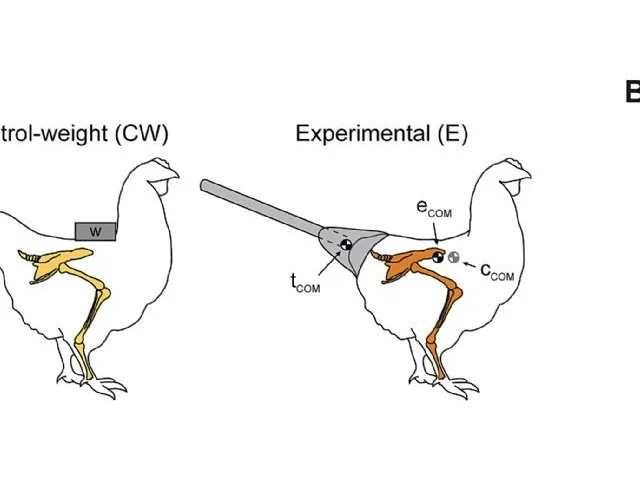False tail shows how dinosaurs walked
301ab7cf-2e3a-430f-83f0-7dc0baaff476

Pinning artificial tails on chickens has possibly revealed how dinosaurs walked.
As has been known for some time now, birds evolved from a particular group of theropod dinosaurs – in fact, birds are dinosaurs as their evolutionary development 'nests' among many of these branches of dinosaur evolution.
However, birds have a mere stump of a tail where the feathers used for steering in flight – effectively the rudder – are attached, while dinosaurs had a long muscular, fleshy tail. So can we see how dinosaurs moved by attaching an artificial tail to a bird? A team of researchers from Chicago, USA, and Santiago, Chile, think so.
Still sharing many traits with their ancestors, birds would seem to be the best model for reconstruction dinosaur locomotion. However, the extant group moves in a different way – the lower limb swings from its knee which is set in a permanent crouched position, whereas it is known that dinosaur legs were constructed in such a way that they swung from the hip, somewhat like in bipedal upright animals such as humans.
The unusual leg posture in birds is reckoned to have come from a realignment of the centre of mass as it moved forward towards the head of the creature as the tail shortened through evolution. to examine the idea that a bird like a chicken could be used to recreate dinosaur locomotion, the centre of mass would have to be artificially shifted backwards, towards the posterior, by attaching an appendage of some sort.
The team attached a sink-plunger like process to the rear of a chicken, and found that, as predicted, the centre of mass did indeed move to a more posterior position, causing the bird's movement to be more hip-driven and more like many other bipedal land animals. While this may seem obvious, a different result could easily have been produced with the technical process of actually replicating the presence of a weighty tail on a bird. Furthermore it proves that such simple techniques can actually be used to examine the physical methods of extinct animal locomotion with some accuracy.
Reference
Grossi, B, Iriarte-Díaz, J, Larach, O, Canals, M, Vásquez, R A. 2014. Walking Like Dinosaurs: Chickens with Artificial Tails Provide Clues about Non-Avian Theropod Locomotion. PLoS ONE 9: e88458.
![]()
As has been known for some time now, birds evolved from a particular group of theropod dinosaurs – in fact, birds are dinosaurs as their evolutionary development 'nests' among many of these branches of dinosaur evolution.
However, birds have a mere stump of a tail where the feathers used for steering in flight – effectively the rudder – are attached, while dinosaurs had a long muscular, fleshy tail. So can we see how dinosaurs moved by attaching an artificial tail to a bird? A team of researchers from Chicago, USA, and Santiago, Chile, think so.
Still sharing many traits with their ancestors, birds would seem to be the best model for reconstruction dinosaur locomotion. However, the extant group moves in a different way – the lower limb swings from its knee which is set in a permanent crouched position, whereas it is known that dinosaur legs were constructed in such a way that they swung from the hip, somewhat like in bipedal upright animals such as humans.
The unusual leg posture in birds is reckoned to have come from a realignment of the centre of mass as it moved forward towards the head of the creature as the tail shortened through evolution. to examine the idea that a bird like a chicken could be used to recreate dinosaur locomotion, the centre of mass would have to be artificially shifted backwards, towards the posterior, by attaching an appendage of some sort.
The team attached a sink-plunger like process to the rear of a chicken, and found that, as predicted, the centre of mass did indeed move to a more posterior position, causing the bird's movement to be more hip-driven and more like many other bipedal land animals. While this may seem obvious, a different result could easily have been produced with the technical process of actually replicating the presence of a weighty tail on a bird. Furthermore it proves that such simple techniques can actually be used to examine the physical methods of extinct animal locomotion with some accuracy.
Reference
Grossi, B, Iriarte-Díaz, J, Larach, O, Canals, M, Vásquez, R A. 2014. Walking Like Dinosaurs: Chickens with Artificial Tails Provide Clues about Non-Avian Theropod Locomotion. PLoS ONE 9: e88458.
.jpg)

